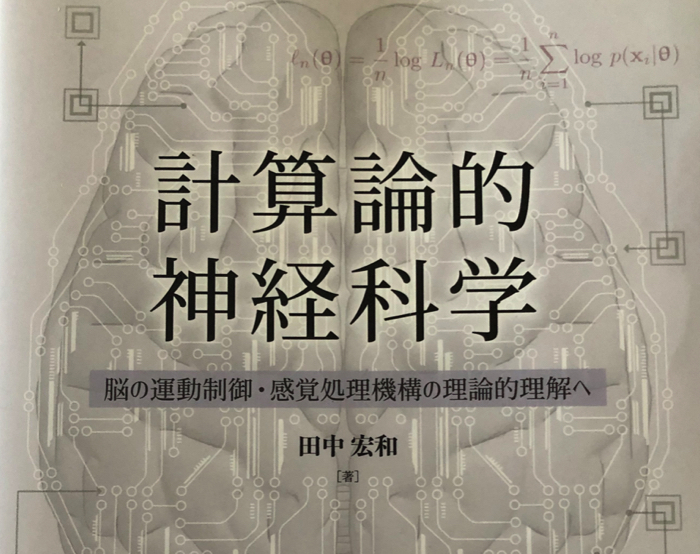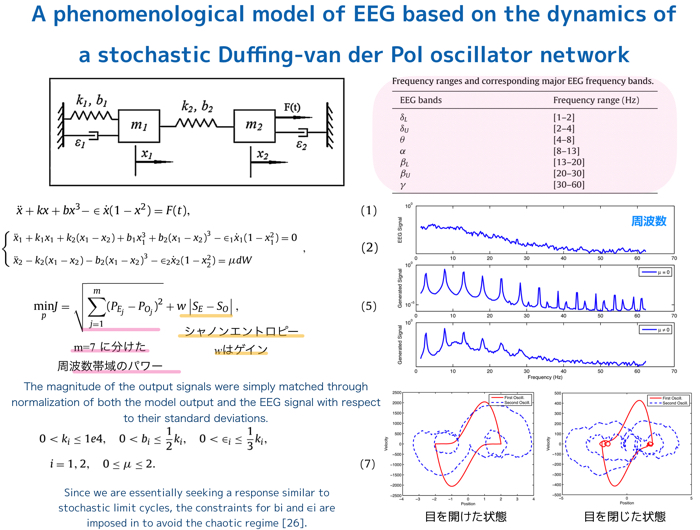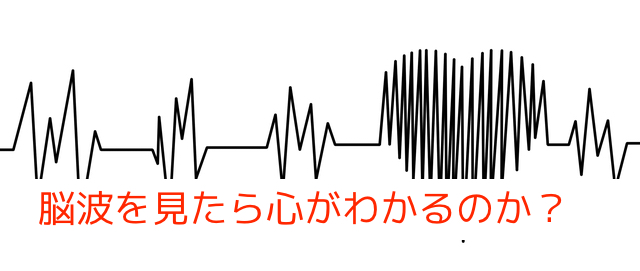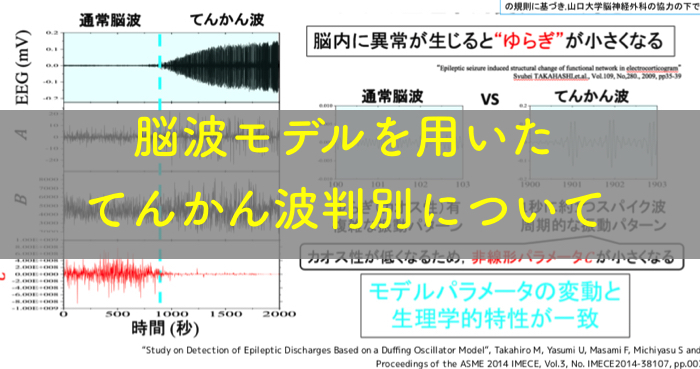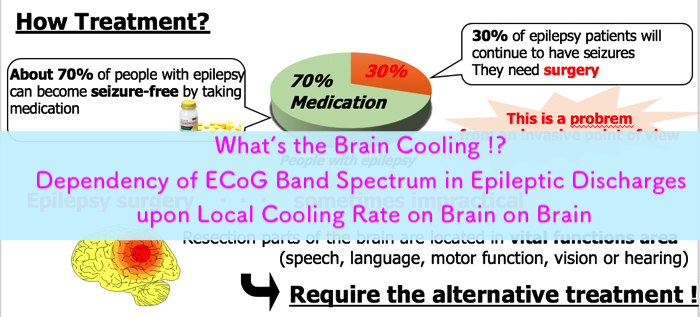
This blog introduce my paper which was published on 2017.
The title is “Dependency of ECoG Band Spectrum in Epileptic Discharges upon Local Cooling Rate on Brain”.
if you want to read this article in Japanese, here.
I’m going to tell you about “epilepsy”, “brain cooling” and “our study report” in this blog.
I hope you will find something new in this article.
What is Epilepsy ?
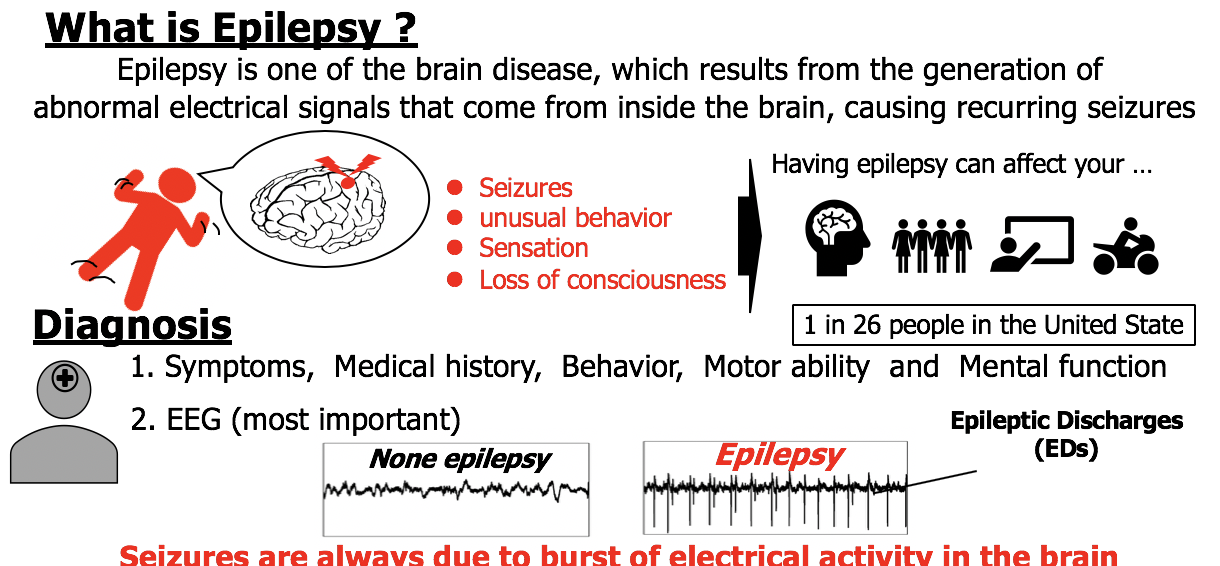
Are you familiar with epilepsy ??
it is a neurological disorder, which results from the generation of abnormal electrical signals that come from inside the brain, causing recurring seizures.
Having epilepsy can affect your safety, relationship, work, driving and so much more.
About 1 in 26 people in the United States will develop an epilepsy.
How does a doctor diagnose epilepsy?
Of course, your doctor will review your symptoms and medical history.
But the most important diagnosis is checking EEG because it records the electrical activity of the brain.
Many people with epilepsy have abnormal EEGs as shown on the right. It is called Epileptic discharges (EDs for short).
EDs have high frequency and magnitude, and They look like spike waves.
How are seizures and epilepsy treated?
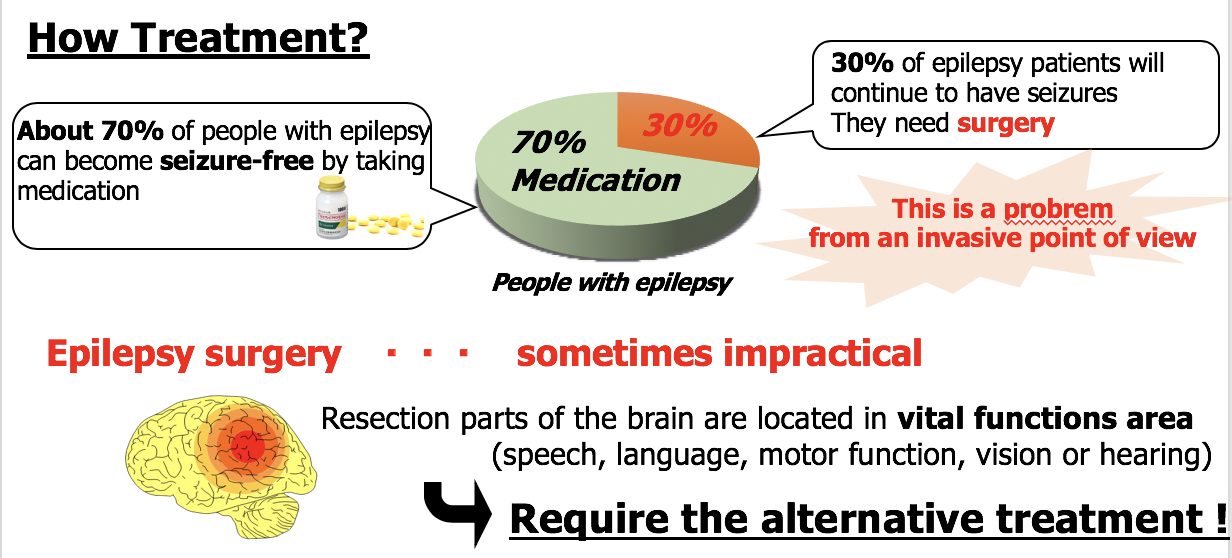
About 70% of people with epilepsy can become seizure-free by taking medication. They will have good seizure control.
Unfortunately, about 30% of epilepsy patients will continue to have seizures even while taking medicine.
Epilepsy surgery should be an option in these patients. This is a problem from an invasive point of view.
Because surgical treatment is always risky and sometimes impractical.
The problem is that, the resection parts are located in vital function areas such as speech, language, motor function, vision or hearing.
Therefore, we need to think about alternative approaches.
Alternative Option : Brain Cooling
Introducing brain cooling treatment
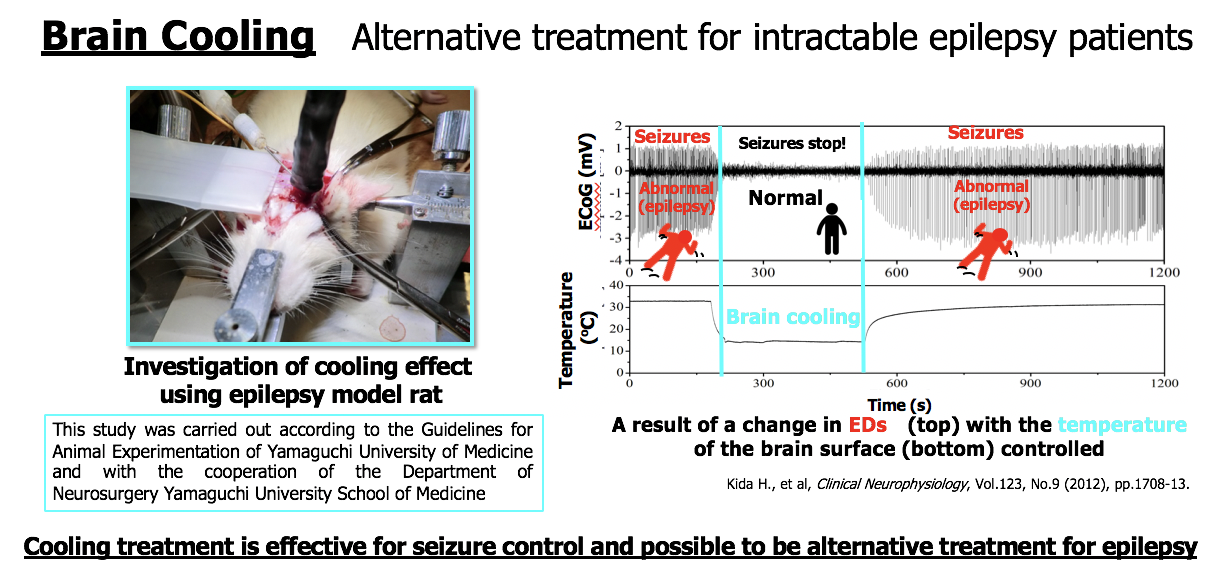
Recently, focal brain cooling began to receive much attention as an alternative treatment tor epilepsy.
So, I’m going to show you how epilepsy treatment works.
We have studied cooling effect using epilepsy model rats.
These 2 graphs on the picture show the brain waves & temperature on the brain surface.
both graphs have a common time on the horizontal axis.
Brain waves show the abnormal state without brain cooling,
however the temperature on the brain was cooled, they show the normal condition.
And then, when cooling stops, the temperature goes back to its original state, the brain waves show the epileptic discharges again.
We can see that the cooling treatment is effective for seizure control.
This could be the next treatment for epilepsy.
What degree is the best for brain cooling ??
I am going to show you the cooling effect on EDs.
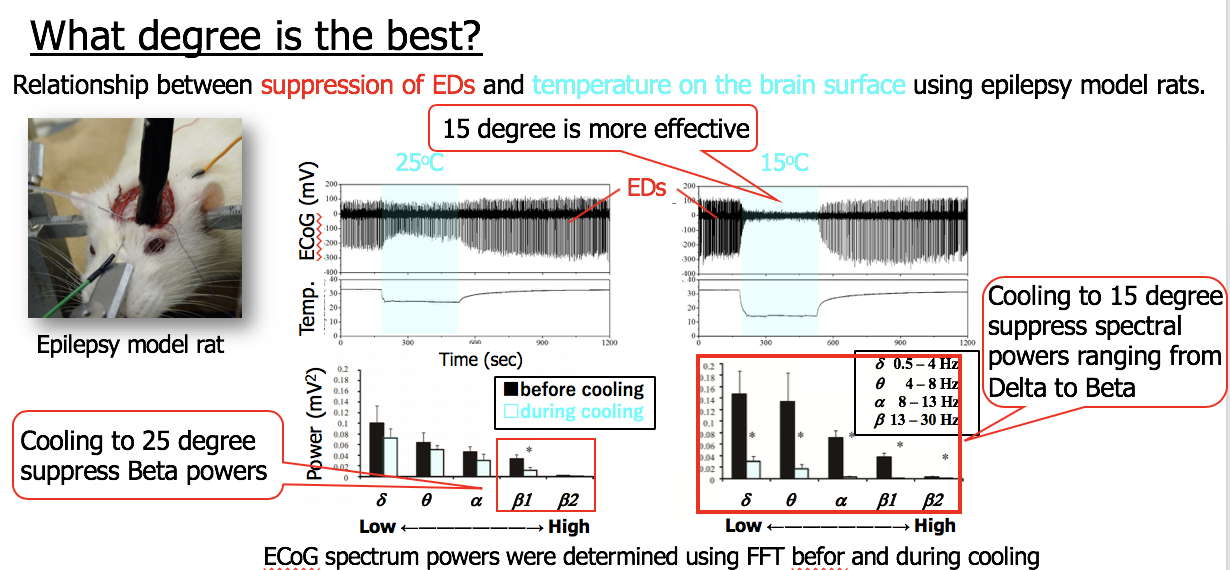
We have studied that the relationship between suppression of EDs and temperature on the brain surface using epilepsy model rats.
Cooling condition of the Left graph is 25 degrees Celsius while the right one is 15 degrees Celsius.
You can see that 15 degrees Celsius more effective because the magnitude of EDs is smaller than the 25 degrees Celsius during cooling.
the previous study showed that the lower temperature is more effective for cooling.
And also, you can see the results of frequency power of EDs before and during cooling.
Cooling to 25 degrees Celsius suppressed only beta power. However, cooing to 15 degrees Celsius suppressed spectral powers ranging from delta to beta bands.
So this frequency analysis tells us that cooling below 25 degrees Celsius may be effective treatment for epilepsy but 15 degrees Celsius is the best in the previous research.
Implant device for cooling treatment

We still have another important question, what is the best cooling rate or cooling speed from initial temperature to 15 degrees Celsius.
It’s important for us to materialize the implant system because we can discuss the performance of the cooling device, requiring electrical power and control method.
Animal Study for “Dependency of ….(title)”
Experiental
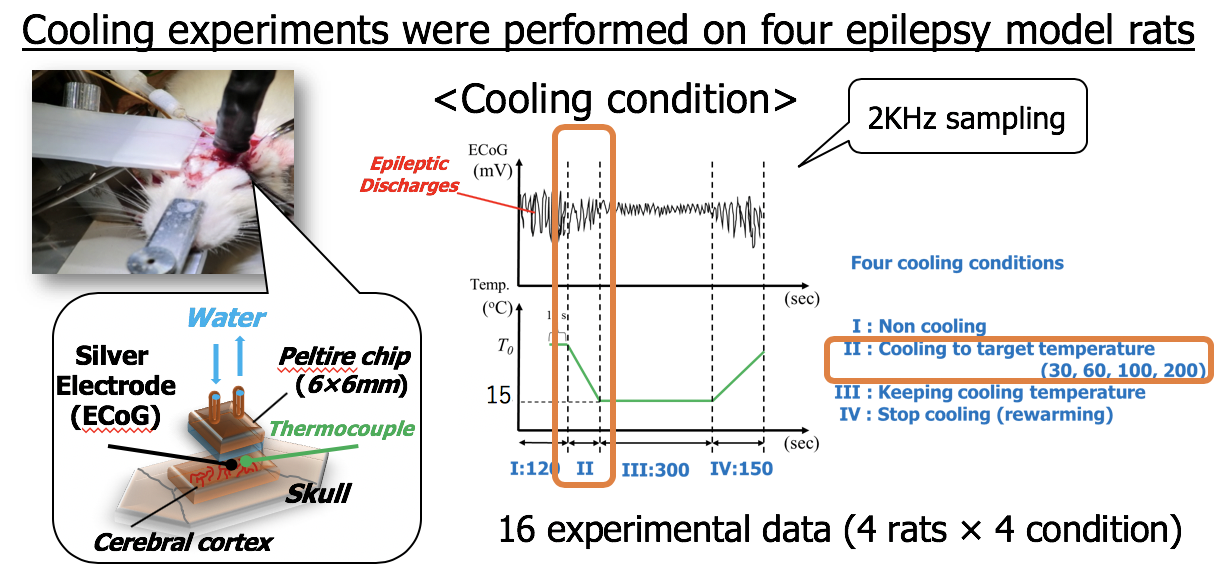
The objective of this study is to investigate the dependence of cooling rate on EDs suppression.
This is the experimental study with four epilepsy model rats.
Their brain was cooled to investigate the effect of cooling rate.
I’m going to show you an analysis using FFT.
And then, to materialize the implant cooling system.
I will show you the results and discuss the cooling rate.
We have four different time conditions to investigate the effect of EDs suppression.
The time conditions in section2 are 30, 60 ,100 and 200 seconds.
The fastest time is 30 seconds and the slowest time is 200 seconds.
I’m going to show you these two results later because it is easy to compare with 30 seconds data and 200 seconds data.
Result and Discussion
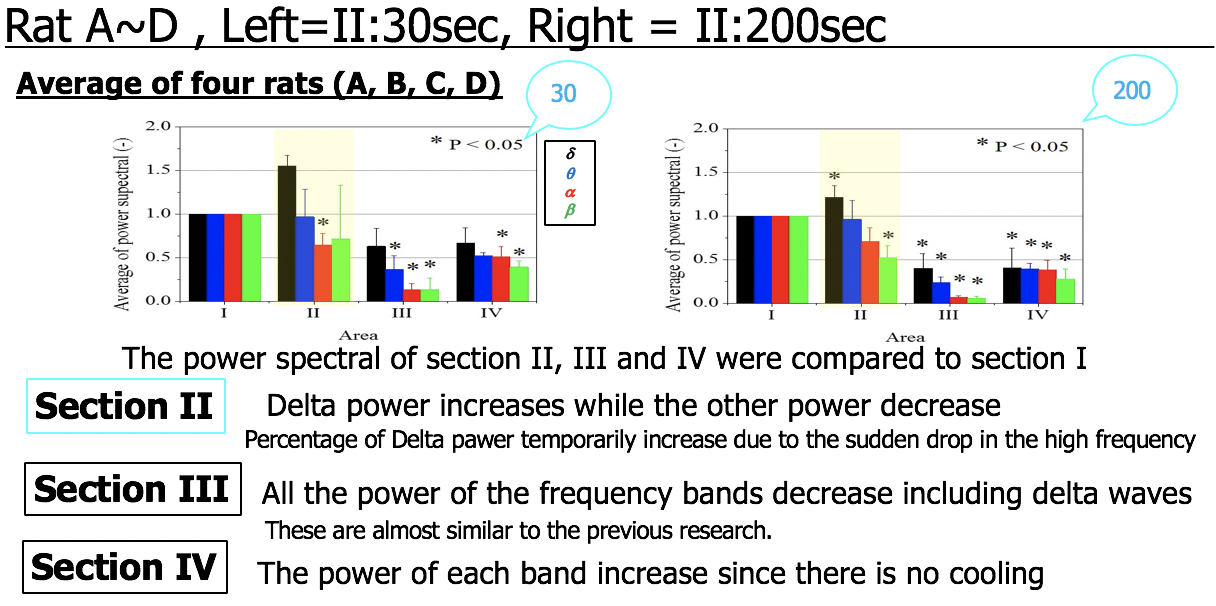
These 2 graphs show the power spectral average of 4 epilepsy model rats.
I have to say that the power spectral of section II, III and IV were compared to section I, cause we need to examine the cooling rate dependency of EDs suppression.
All results are expressed as mean ± standard error.
And also, paired t-test was used for comparison of non-cooling section I and the order sections.
In section II, you can see the delta wave increases while the other waves decrease.
It always happens that the percentage of the delta waves temporarily increase due to the sudden drop in the high frequency component.
In the section III,
you can see all the power of the frequency bands decrease including the delta band, no exceptions.
These frequency analysis are almost similar to the previous research
In the section IV,
the power of each band increases since there is no cooling.
And different cooling conditions like 30 seconds or 200 seconds have almost the same results in the sections.
Interestingly, slower cooling on the brain can always effectively suppress power spectral.
This table is the comparison of section III of power spectrum.
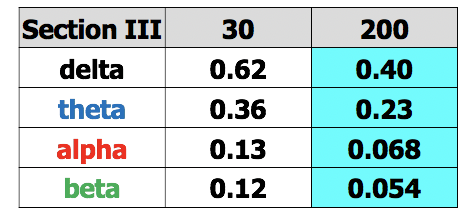
You can see the evidence that slower cooling has better result.
Each power spectral is smaller than faster cooling condition.
it is generally thought that quickly cooling to the target temperature is preferable.
However, our results suggested that slower cooling is better for suppression of EDs.
if you want more detail information, see this document.

